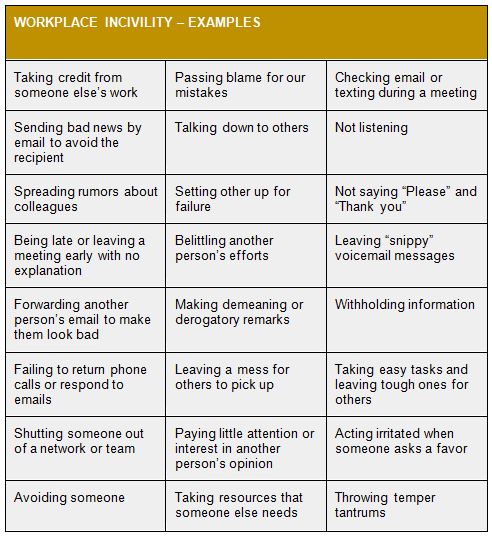How Incivility and Employee Engagement Impact Workplace Violence Prevention

In response to some shocking, tragic, and highly-publicized mass shootings in the 1980’s and 90’s, Workplace Violence training got its start with an emphasis on how to survive a worst-case scenario like an active shooter event. But as people began to acclimate to this emerging reality, they eventually began to ask, “how can we keep this kind of thing from happening in the first place?” As such, training evolved to include prevention concepts in addition to survival guidance. This included an examination of the concerning behaviors that can signal someone may be on a path towards violence, as well as the need to take action by bringing concerns forward if such behaviors are observed.
Increasingly, though, there are efforts to push workplace violence prevention even further upstream. Here, we begin to step into behavioral territory that isn’t so much focused on “behavior that generate[s] a concern for safety from violence due to its nature and severity,” as articulated by the American National Standard on Workplace Violence Prevention and Intervention,¹ as much as behaviors that can be categorized as “uncivil.”
In 1999, Anderson and Pearson captured a definition of Workplace Incivility that still holds as the standard today:
"Workforce Incivility is a low intensity deviant behavior with ambiguous intent to damage the target, in violation of workplace norms for mutual respect. Uncivil behaviors are characteristically rude and discourteous, displaying a lack of regard for others.” ²


And though workplace incivility is labeled “low intensity,” studies are finding that the impact of these types of behavior is anything but “low impact.”
Workplace incivility is a corrosive form of interpersonal communication that also has a powerful emotional contagion effect. People tend to bring the toxic effects of workplace incivility home with them, negatively impacting their family members as well.
The Anxiety and Depression Association of America reported that stress and anxiety have several direct impacts on job performance (such as overall performance and quality of work) with the second highest cause of work-related stress being “interpersonal relationships.”³
The measurable cost of workplace incivility is substantial. In a nationwide poll of 800 managers and employees across 17 industries, Christine Porath and her colleague Christine Pearson learned that “among workers who have been on the receiving end of incivility:”
-
- 48% intentionally decreased their work effort
- 47% intentionally decreased their time spent at work
- 38% intentionally decreased the quality of their work
- 80% lost work time worrying about the incident
- 63% lost work time avoiding the offender
- 66% said their performance declined,
- 78% said their commitment to the organization declined
- 12% said they had left their job because of the uncivil treatment
- 25% admitted to taking their frustration out on customers⁴
Surprisingly, incivility often grows out of ignorance and not malice and may be the result of factors such as differing cultural mores or generational differences. (And haven’t we all committed acts of mindless or inadvertent carelessness within our professional relationships?)
Incivility also has a cumulative effect and can result in a breakdown of relationship, which can lead to a loss of goodwill between individuals. And, it is this pre-conflict stage where hostile intent can develop and harassment and lateral violence can begin to emerge in the work environment.
Harassment: Abusive behaviors with a systematic intent to damage the target.
Lateral violence: Consistent behavioral patterns planned with the aim to control, belittle, or devalue a group of peers.⁵
Based on the significant toxic impact that incivility can have in our workplaces, and given that workplace incivility can readily metastasize into workplace violence, it’s imperative that any mature organizational workplace violence prevention program also include a serious push into the awareness and recognition of workplace incivility. As such:
- Organizational leadership should reinforce the necessity of bringing uncivil behavioral concerns forward to management and/or HR -- and additionally work to ensure they’re creating and nurturing a workplace culture that makes it safe to do so.
- It is advisable to help employees and associates become familiar with, and master, verbal de-escalation skills and techniques that are often effective at cooling expressive encounters. (This is both a science and an art and requires both practice and continued use in order to maintain proficiency).
Of course, as we continue to move upstream into behaviors that are less aggressive and more civil, we actually begin to transition to a place where an organization’s foundational values and culture come into view. This is where senior leadership has its greatest influence and role. And while it falls outside the scope of this post to address details here, it’s vitally important to emphasize the intrinsic connection between organizational culture and the risk of interpersonal violence. Issues such as employee connectedness, enthusiasm, and commitment to an organization's mission and vision are clearly connected to organizational safety.
Gallup’s 2016 meta-analysis study, which examined more than 82,000 business units and 1.8 million employees in 230 organizations, across 49 industries and in 73 countries, showed that business units with employee “engagement scores” in the top quartile of Gallup’s employee engagement database have a whopping 70% fewer safety incidents compared with bottom-quartile units.⁶
And while “safety” is a broad term, it’s important to point out that OSHA considers workplace violence to fall within the purview of the Occupational Safety and Health Act’s General Duty Clause, which requires employers to provide a safe and healthful workplace for all workers covered by the OSHA Act.
Finally, there is ample evidence to suggest that strong social bonds within an organization positively affect employee retention and performance while simultaneously deterring malicious insider acts.⁷
Creating a Culture of Looking Out for One Another
As workplace violence prevention continues to mature and expand, it seems natural that its focus would additionally extend to critical factors like employee engagement and connection to an organization’s vision and mission. As such, exciting new soft skills and behaviors could be promoted and nurtured. For instance, in the area of changing and cultivating organizational culture, there’s an emerging field of training known as “Bystander Training.” Jean Stapleton, co-director of the Prevention Innovations Research Center at the University of New Hampshire, says that bystander training is all about leveraging the people in the work environment to set the tone for what’s acceptable and what’s not acceptable behavior.


This is a powerful concept since “bystander interventions” typically occur long before an incident of harassment, aggression, or violence can begin and negative communication patterns gain inertia. Casual conversations surrounding respectful workplace behaviors “normalize” such discussions and interactions and make it easier for coworkers to see and give negative feedback if an employee seems to be straying outside of appropriate organizational norms. In an example cited in Harvard Business Review, Fran Sepler—a consultant, trainer, and investigator on workplace harassment prevention for more than 30 years—demonstrated how that might sound; “So, when a coworker tells an offensive joke, it’s easier to say, ‘Remember how we talked and agreed about what’s OK to say at work? That’s not it.”⁸
Bystander training can help to set up feedback-rich environments where harassing or offensive situations are immediately addressed and potentially diffused through a variety of communication techniques. Mid-level managers can also be taught to respond to complaints and issues in an emotionally intelligent way, which can help create an environment where employees feel comfortable speaking up as well as listening, no matter what the issue might be.


And so, perhaps at this point, we will have pushed prevention as far forward as possible. We’ll have navigated the worst-case scenarios, pushed through the basics of interpersonal violence awareness, presented a recognition of the toxic effects of workplace incivility; and finally reached to the cultural foundations of the organization. The hope is that in doing this we will collectively realize a fundamental truth of any organization or social assembly: while each and every individual is decidedly unique…together, we have a collective power to create an environment of dignity and respect. It is in environments where people feel connected and supported that our most healthy and safe work places can be established and grown.


James Sporleder has more than 25 years' experience in the security industry. With a unique background in specialized captivity survival, James has trained thousands of US military personnel from one of the most elite units in the US Department of Defense. He’s worked in the corporate arena for more than 17 years, focusing on the development and implementation of specialized training programs and helping more than 50 percent of the Fortune 100 prepare for and respond to emerging challenges related to workplace violence, intimate partner violence, and extreme violence such as active shooter.
[1] Workplace Violence and Active Assailant-Prevention, Intervention, and Response, ASIS WVPI AA-2020, ASIS International, June 2020
[2] Tit for Tat? The Spiraling Effect of Incivility in the Workplace, Anderson and Pearson, The Academy of Management Review 24(3):452-471, DOI: 10.2307/259136, July 1999 [internet]
[3] “Highlights: Workplace Stress and Anxiety Disorders Survey,” Anxiety and Depression Association of America website, 2006, https://adaa.org/workplace-stress-anxiety-disorders-survey
[4] Christine Porath, Mastering Civility, A Manifesto for the Workplace, Grand Central Publishing, New York, 2016
[5] Preventing workplace incivility, lateral violence, and bullying between nurses. A narrative literature review. Bambi, et.al., 2017
[6] Engaged Workplaces Are Safer for Employees, Gallup, 24 May 2016
[7] T. Hirschi, Causes of delinquency. Transaction Publishers, 2002, cited in CERT 2018 IEEE Symposium
[8] To Combat Harassment, More Companies Should Try Bystander Training, Brigid Schulte, Harvard Business Review, 31 October 2018


